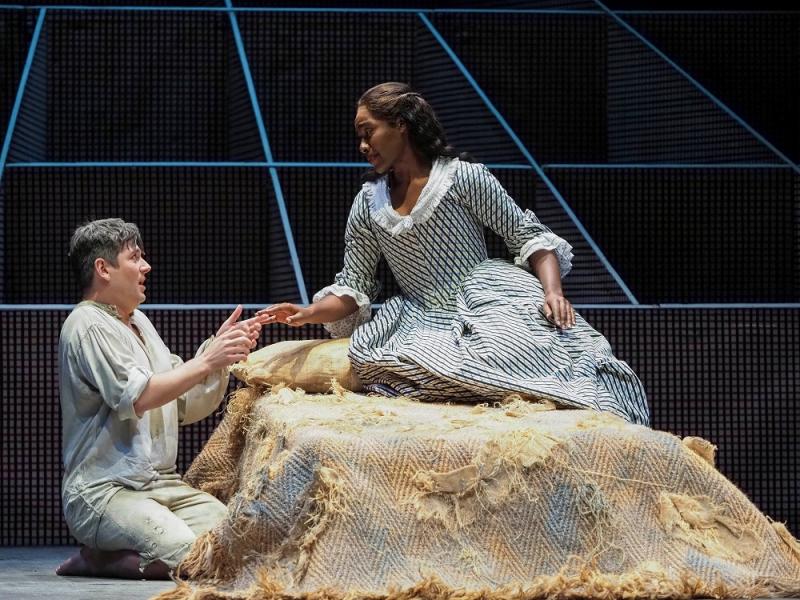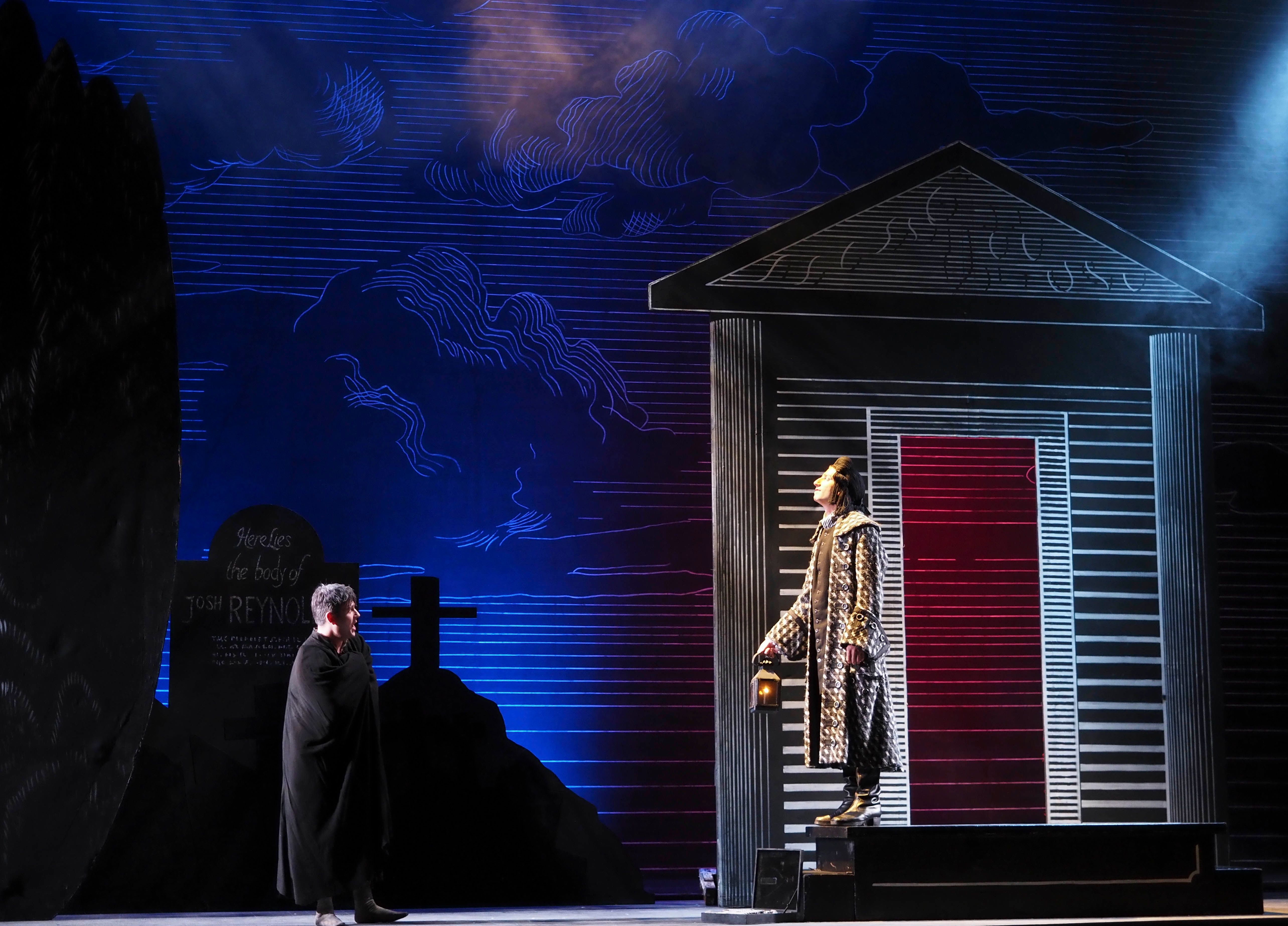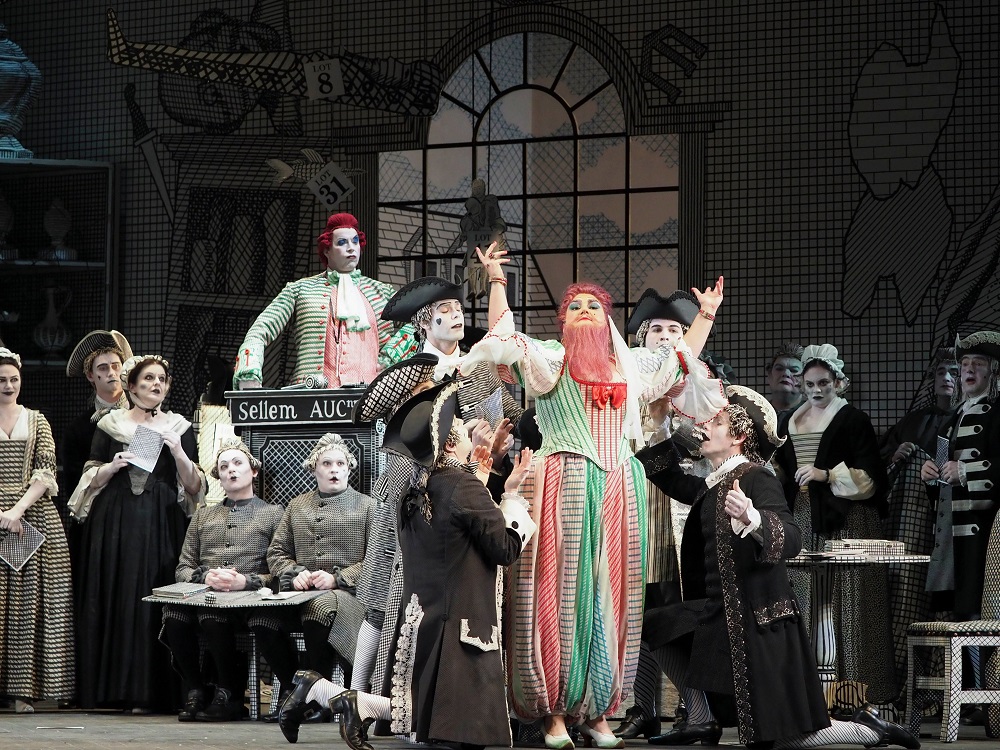The Rake's Progress, Glyndebourne Tour - a classic revitalized | reviews, news & interviews
The Rake's Progress, Glyndebourne Tour - a classic revitalized
The Rake's Progress, Glyndebourne Tour - a classic revitalized
A new generation responds vibrantly to Hockney, Cox, Stravinsky, Auden and Kallman

Tom Rakewell Esquire, the Glyndebourne edition generally known as “the Hockney Rake” though it is very much director John Cox’s too, is 46 years old.
Choral excellence in the tricky but rewarding set-pieces of brothel, auction and Bedlam scene tends to be a given with the promising ensemble at Glyndebourne (more stars are waiting to be born in this yeat's vintage, not least bass Tom Mole). Two of the four principals, Frederick Jones as weak but not wicked Tom Rakewell and Sam Carl as Nick Shadow, the puppetmaster who loses control when true love’s at stake, have come on in leaps and bounds since their already excellent performances for British Youth Opera in 2018, Jones, still technically the most secure Tom I’ve ever heard, now finds more nuance and pathos in the later stages, while Carl (pictured below with Jones in the graveyard scene) sounds supreme in the powerful bass-baritone moments - could this be a Wotan in the making? - but has also mastered the art of sinister confidentiality.  Nardus Williams is now Ann Trulove, the sweet girl who also has strength of purpose enough to pursue her feckless deserter. It was going to take a lot to equal Samantha Clarke’s consummate portrayal for BYO, but Williams does it on her own terms. The timbre is fast-vibratoed and sometimes darker than that of the usual lyric soprano, but she puts no foot wrong when it comes to phrasing, top notes or projection of the sense. Rosie Aldridge makes it clear that elocution lessons have been part of the progress for Baba the Turk, bearded lady of St Giles Fair (pictured below in the auction scene with members of the chorus and Daniel Norman as Sellem), whom Tom marries in an whimsical existential challenge. What a difference it makes, frankly, when English is the mother tongue of the singers; that makes this a more successful Rake than the main season revival of 11 years ago, where three of the principals were Swedish, Finnish and Russian – good voices and actors all, but something was lost there, and this demonstrates exactly what.
Nardus Williams is now Ann Trulove, the sweet girl who also has strength of purpose enough to pursue her feckless deserter. It was going to take a lot to equal Samantha Clarke’s consummate portrayal for BYO, but Williams does it on her own terms. The timbre is fast-vibratoed and sometimes darker than that of the usual lyric soprano, but she puts no foot wrong when it comes to phrasing, top notes or projection of the sense. Rosie Aldridge makes it clear that elocution lessons have been part of the progress for Baba the Turk, bearded lady of St Giles Fair (pictured below in the auction scene with members of the chorus and Daniel Norman as Sellem), whom Tom marries in an whimsical existential challenge. What a difference it makes, frankly, when English is the mother tongue of the singers; that makes this a more successful Rake than the main season revival of 11 years ago, where three of the principals were Swedish, Finnish and Russian – good voices and actors all, but something was lost there, and this demonstrates exactly what.
As in the BYO production, every word can be heard; it takes a lot of work to achieve that. When the supertitles drop out for what was originally conceived as recitative – but the ever-chameleonic Stravinsky doesn’t always treat it as such – you don’t have to work hard to catch the supreme eloquence of the Auden-Kallman libretto, surely the 20th century best alongside Hofmannsthal’s for Strauss in Der Rosenkavalier and Eric Crozier’s for Britten in Albert Herring (another Glyndebourne opera, incidentally, which Haitink surprised everyone by taking on). Concordance with the pit seems good; Hasan goes for pastels rather than poster-paints until the drama goes up several notches, but it’s elegant and especially fine dealing with Stravinsky’s stylistic sleights of hand, often within single numbers.  The Hockney designs’ one major flaw remains the long breaks between scenes – Stravinsky designs each group of three in each of the three acts to flow harmonically – but the pauses have at least been reduced to a minimum. And the rewards are so great, as the gasp of the audience at each new tableau indicates, that it’s easy enough to ignore a given. So scene-stealing are they, if you’ll pardon the expression, that Cox’s inventiveness with detail can easily be overlooked. From the meticulous groupings of the chorus, including the queasy Black Mass of “Lanterloo” in the brothel, to as telling a comic touch as Tom wearily handing Baba another plate to smash in her high dudgeon, it all comes across vividly still.
The Hockney designs’ one major flaw remains the long breaks between scenes – Stravinsky designs each group of three in each of the three acts to flow harmonically – but the pauses have at least been reduced to a minimum. And the rewards are so great, as the gasp of the audience at each new tableau indicates, that it’s easy enough to ignore a given. So scene-stealing are they, if you’ll pardon the expression, that Cox’s inventiveness with detail can easily be overlooked. From the meticulous groupings of the chorus, including the queasy Black Mass of “Lanterloo” in the brothel, to as telling a comic touch as Tom wearily handing Baba another plate to smash in her high dudgeon, it all comes across vividly still.
I’d ditch the dry ice in the graveyard scene, but how deep the blues are now both there and for Anne’s aria of determination; like Cox, the original lighting designer, Robert Bryan, has returned, but I wonder if he’s taken the opportunity to use advances in his sphere to make the colours even deeper and richer. A feast for the eye as well as ear, heart as well as mind. On the first night, despite previous coughing bouts among a refreshingly masked audience, you could feel the intensity of the silences for the graveyard and asylum denouements. Go, and take an operatic newcomer along.
rating
Explore topics
Share this article
The future of Arts Journalism
You can stop theartsdesk.com closing!
We urgently need financing to survive. Our fundraising drive has thus far raised £49,000 but we need to reach £100,000 or we will be forced to close. Please contribute here: https://gofund.me/c3f6033d
And if you can forward this information to anyone who might assist, we’d be grateful.

Subscribe to theartsdesk.com
Thank you for continuing to read our work on theartsdesk.com. For unlimited access to every article in its entirety, including our archive of more than 15,000 pieces, we're asking for £5 per month or £40 per year. We feel it's a very good deal, and hope you do too.
To take a subscription now simply click here.
And if you're looking for that extra gift for a friend or family member, why not treat them to a theartsdesk.com gift subscription?
more Opera
 La bohème, Opera North review - still young at 32
Love and separation, ecstasy and heartbreak, in masterfully updated Puccini
La bohème, Opera North review - still young at 32
Love and separation, ecstasy and heartbreak, in masterfully updated Puccini
 Albert Herring, English National Opera review - a great comedy with depths fully realised
Britten’s delight was never made for the Coliseum, but it works on its first outing there
Albert Herring, English National Opera review - a great comedy with depths fully realised
Britten’s delight was never made for the Coliseum, but it works on its first outing there
 Carmen, English National Opera review - not quite dangerous
Hopes for Niamh O’Sullivan only partly fulfilled, though much good singing throughout
Carmen, English National Opera review - not quite dangerous
Hopes for Niamh O’Sullivan only partly fulfilled, though much good singing throughout
 Giustino, Linbury Theatre review - a stylish account of a slight opera
Gods, mortals and monsters do battle in Handel's charming drama
Giustino, Linbury Theatre review - a stylish account of a slight opera
Gods, mortals and monsters do battle in Handel's charming drama
 Susanna, Opera North review - hybrid staging of a Handel oratorio
Dance and signing complement outstanding singing in a story of virtue rewarded
Susanna, Opera North review - hybrid staging of a Handel oratorio
Dance and signing complement outstanding singing in a story of virtue rewarded
 Ariodante, Opéra Garnier, Paris review - a blast of Baroque beauty
A near-perfect night at the opera
Ariodante, Opéra Garnier, Paris review - a blast of Baroque beauty
A near-perfect night at the opera
 Cinderella/La Cenerentola, English National Opera review - the truth behind the tinsel
Appealing performances cut through hyperactive stagecraft
Cinderella/La Cenerentola, English National Opera review - the truth behind the tinsel
Appealing performances cut through hyperactive stagecraft
 Tosca, Royal Opera review - Ailyn Pérez steps in as the most vivid of divas
Jakub Hrůša’s multicoloured Puccini last night found a soprano to match
Tosca, Royal Opera review - Ailyn Pérez steps in as the most vivid of divas
Jakub Hrůša’s multicoloured Puccini last night found a soprano to match
 Tosca, Welsh National Opera review - a great company reduced to brilliance
The old warhorse made special by the basics
Tosca, Welsh National Opera review - a great company reduced to brilliance
The old warhorse made special by the basics
 BBC Proms: The Marriage of Figaro, Glyndebourne Festival review - merriment and menace
Strong Proms transfer for a robust and affecting show
BBC Proms: The Marriage of Figaro, Glyndebourne Festival review - merriment and menace
Strong Proms transfer for a robust and affecting show
 BBC Proms: Suor Angelica, LSO, Pappano review - earthly passion, heavenly grief
A Sister to remember blesses Puccini's convent tragedy
BBC Proms: Suor Angelica, LSO, Pappano review - earthly passion, heavenly grief
A Sister to remember blesses Puccini's convent tragedy
 Orpheus and Eurydice, Opera Queensland/SCO, Edinburgh International Festival 2025 review - dazzling, but distracting
Eye-popping acrobatics don’t always assist in Gluck’s quest for operatic truth
Orpheus and Eurydice, Opera Queensland/SCO, Edinburgh International Festival 2025 review - dazzling, but distracting
Eye-popping acrobatics don’t always assist in Gluck’s quest for operatic truth

Add comment